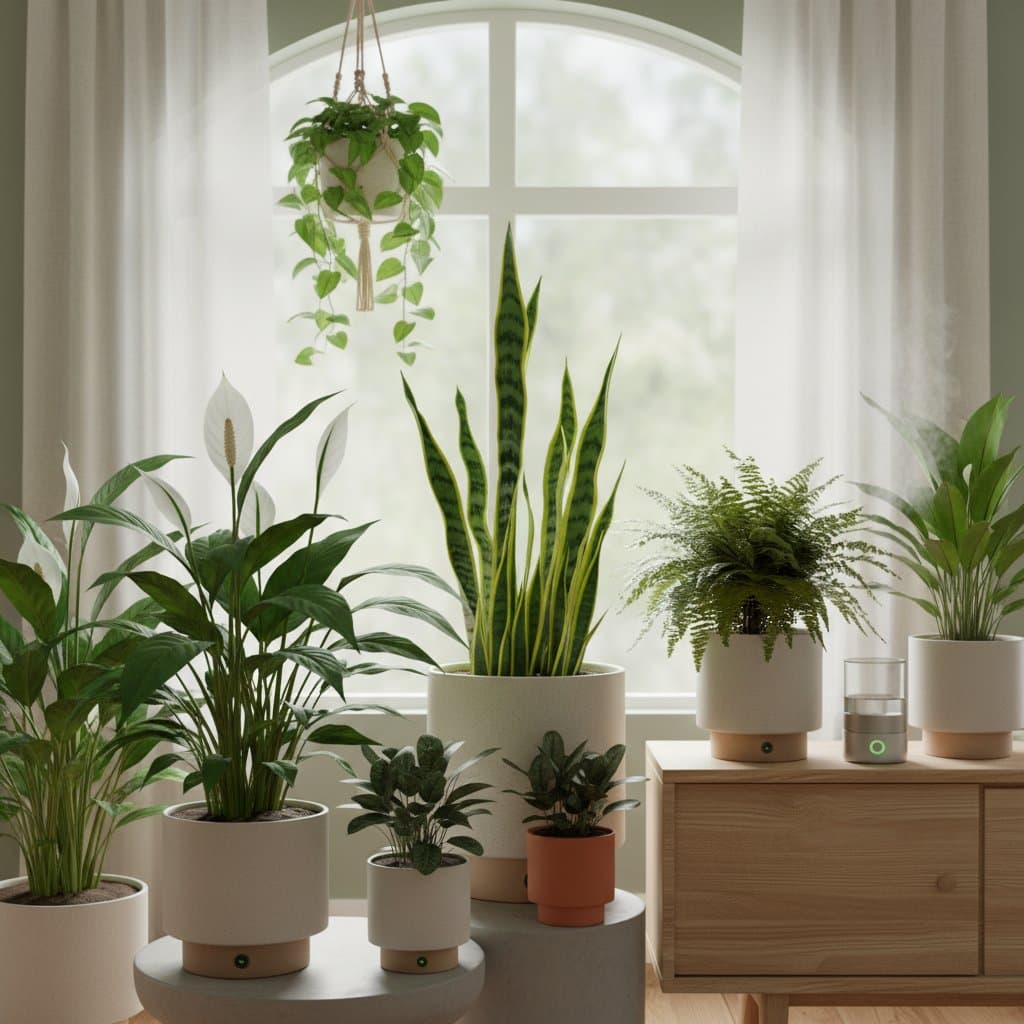1. English Ivy (Hedera helix)
English ivy effectively absorbs excess moisture and reduces mold spores in humid settings. This plant flourishes in cooler areas with indirect light. Consider using hanging baskets or wall-mounted planters to accommodate its trailing vines, which soften vertical surfaces. The dense foliage traps airborne particles and refreshes stagnant air.
Maintenance tip: Prune the plant regularly to manage growth and promote fresh leaves. Apply a balanced fertilizer every few weeks during the growing season to maintain lush foliage. Water when the top inch of soil feels dry, ensuring good drainage to prevent root issues.
2. Spider Plant (Chlorophytum comosum)
Spider plants demonstrate resilience, rapid growth, and straightforward care requirements. Their arching leaves and small offshoots, known as pups, add visual energy to any space. These plants release a moderate amount of moisture, which elevates humidity levels without creating a heavy atmosphere. In addition, they remove carbon monoxide and formaldehyde, enhancing air clarity in compact areas.
Placement idea: Suspend a spider plant near a window in the kitchen or hallway. This arrangement utilizes vertical space effectively while purifying the surrounding air. Propagate new plants from the pups for easy expansion of your collection.
3. Rubber Plant (Ficus elastica)
Rubber plants feature large, glossy leaves that command attention. They require bright, indirect light and watering only when the soil surface dries out. The substantial leaves filter toxins efficiently and introduce a sculptural element to interiors. Their broad surface area aids in subtle humidity regulation, particularly in medium-sized rooms.
Styling suggestion: Position a rubber plant in a woven basket or on a rattan stand to add warmth. The dark foliage provides strong contrast against light walls and neutral flooring. Dust the leaves monthly to optimize their air-purifying function.
4. Aloe Vera
Aloe vera gains recognition for its soothing gel, yet it serves as an outstanding air purifier as well. This plant thrives in dry conditions, ideal for countering excess humidity in moist rooms. Site it in bright light, such as on a sunny windowsill. The thick leaves store water and release it slowly, preventing overly dry air without fostering mold growth.
Bonus use: Maintain a compact aloe vera in the kitchen for immediate access to gel that soothes minor burns or skin irritations. Harvest the gel by slicing a leaf lengthwise and scooping out the clear interior. Replant offsets to sustain the plant's vigor.
Developing a Customized Plant Strategy for Your Home
Selecting plants to balance humidity and elevate air quality requires attention to specific room conditions. Begin by assessing areas that feel excessively dry or overly damp. Then, select species that address those challenges directly.
- Dry living rooms: Opt for peace lily, Boston fern, or areca palm to introduce needed moisture.
- Humid bathrooms: Choose English ivy or aloe vera to absorb surplus dampness.
- Low-light bedrooms: Select snake plant or spider plant for reliable performance in dim settings.
- Bright kitchens: Incorporate rubber plant or aloe vera to handle variable light and humidity.
Assemble plants in groups of three to five for amplified effects. The collective transpiration from several plants generates a localized microclimate that feels invigorating and balanced. Vary heights and leaf textures within the cluster to enhance visual appeal and maximize air quality improvements.
Optimizing Lighting and Placement
Position humidity-tolerant plants, such as ferns and palms, near windows with filtered sunlight or in moisture-rich areas like bathrooms. Plants adapted to drier air, including snake plants and aloe vera, benefit from bright indirect light and infrequent watering. Rotate pots every two to three weeks to ensure even light distribution across all sides.
In rentals with scarce natural light, introduce a grow bulb via a basic table lamp. Provide artificial illumination for several hours each day to support healthy growth. Monitor plant response and adjust placement as seasons change to maintain optimal conditions.
Essential Care Practices for Superior Air Quality
The effectiveness of a plant in purifying air hinges on its overall health. Gently wipe leaves with a damp cloth monthly to clear dust accumulation. This practice keeps the leaf pores unobstructed, allowing efficient gas exchange.
Prevent overwatering, as it invites root rot and mold that undermine air benefits. Select appropriate soil mixes during repotting: well-draining cactus blend for aloe vera, or moisture-holding varieties for ferns. Address signs of distress, such as drooping or yellowing leaves, by refining watering routines or relocating to steadier light sources.
In a compact apartment setting, position a peace lily by the entrance and suspend a spider plant over the sink. These choices sustain fresh air circulation, even during extended periods with closed windows.
Sustaining a Healthier Indoor Environment
Incorporating plants that regulate humidity and cleanse air elevates a home from functional to nurturing. The atmosphere becomes gentler, the ambiance more serene, and the bond with nature more profound. Observe the gradual unfurling of a fern or the emergence of a new leaf on a rubber plant; such moments deliver a sense of fulfillment unmatched by mechanical devices.
